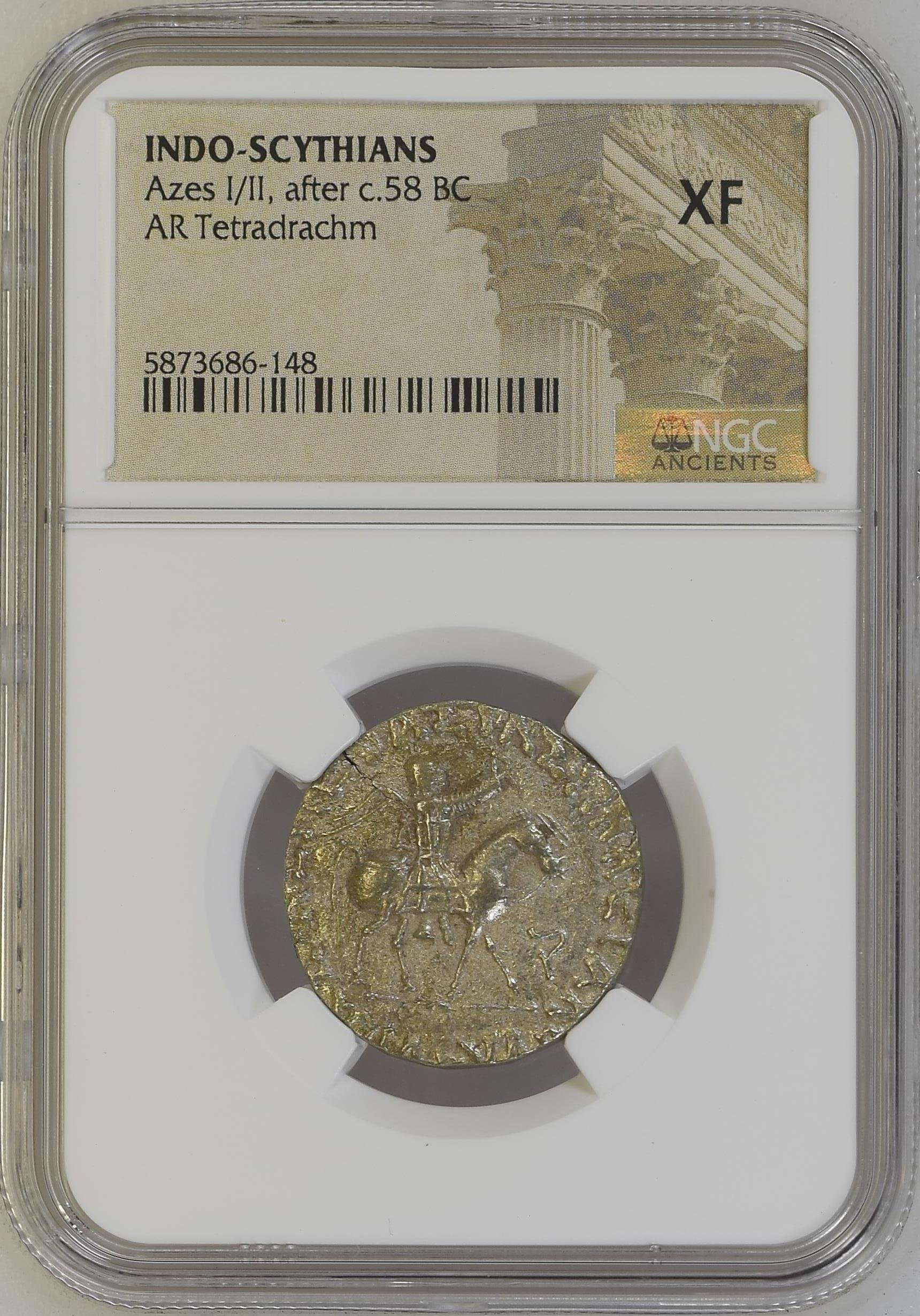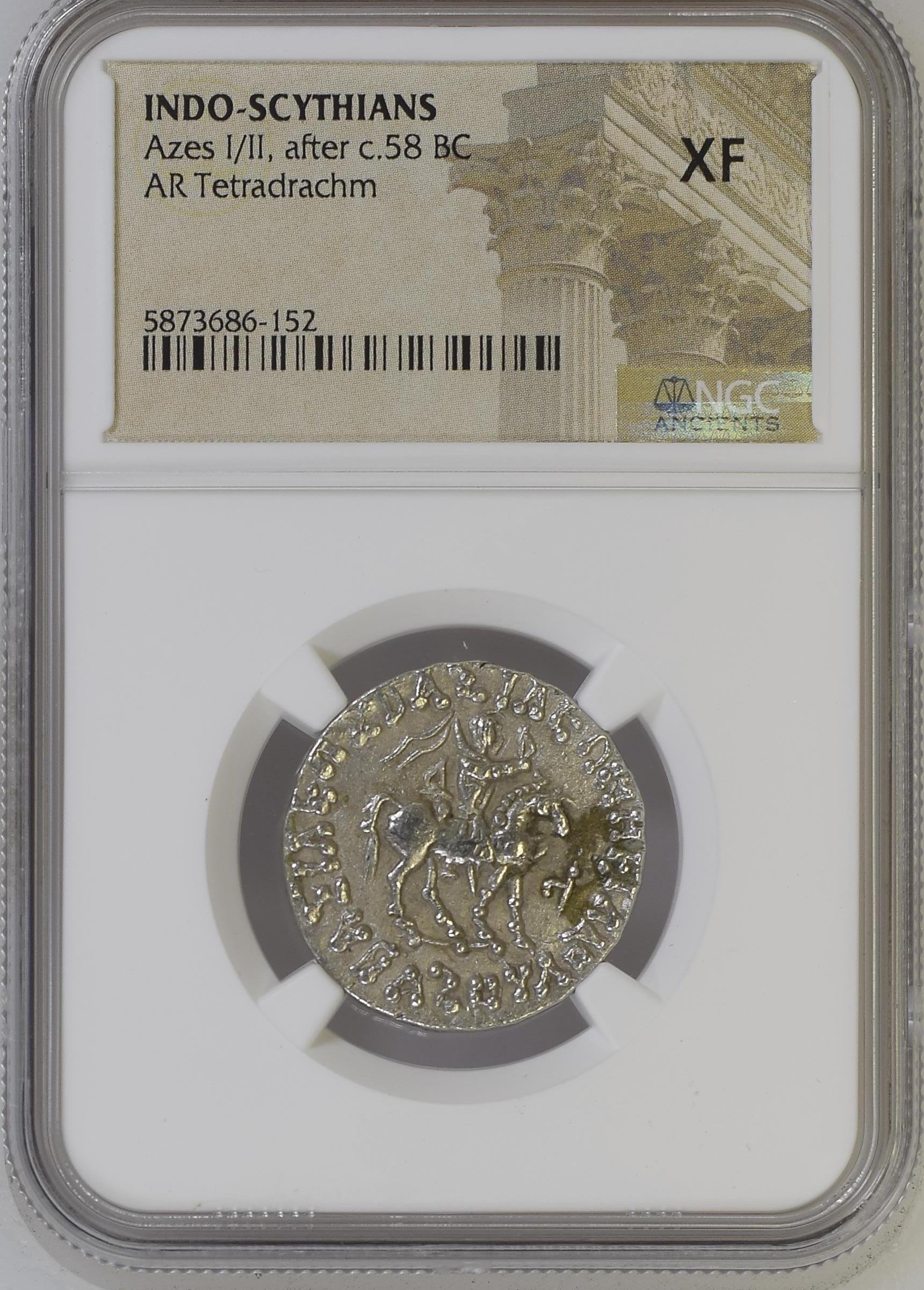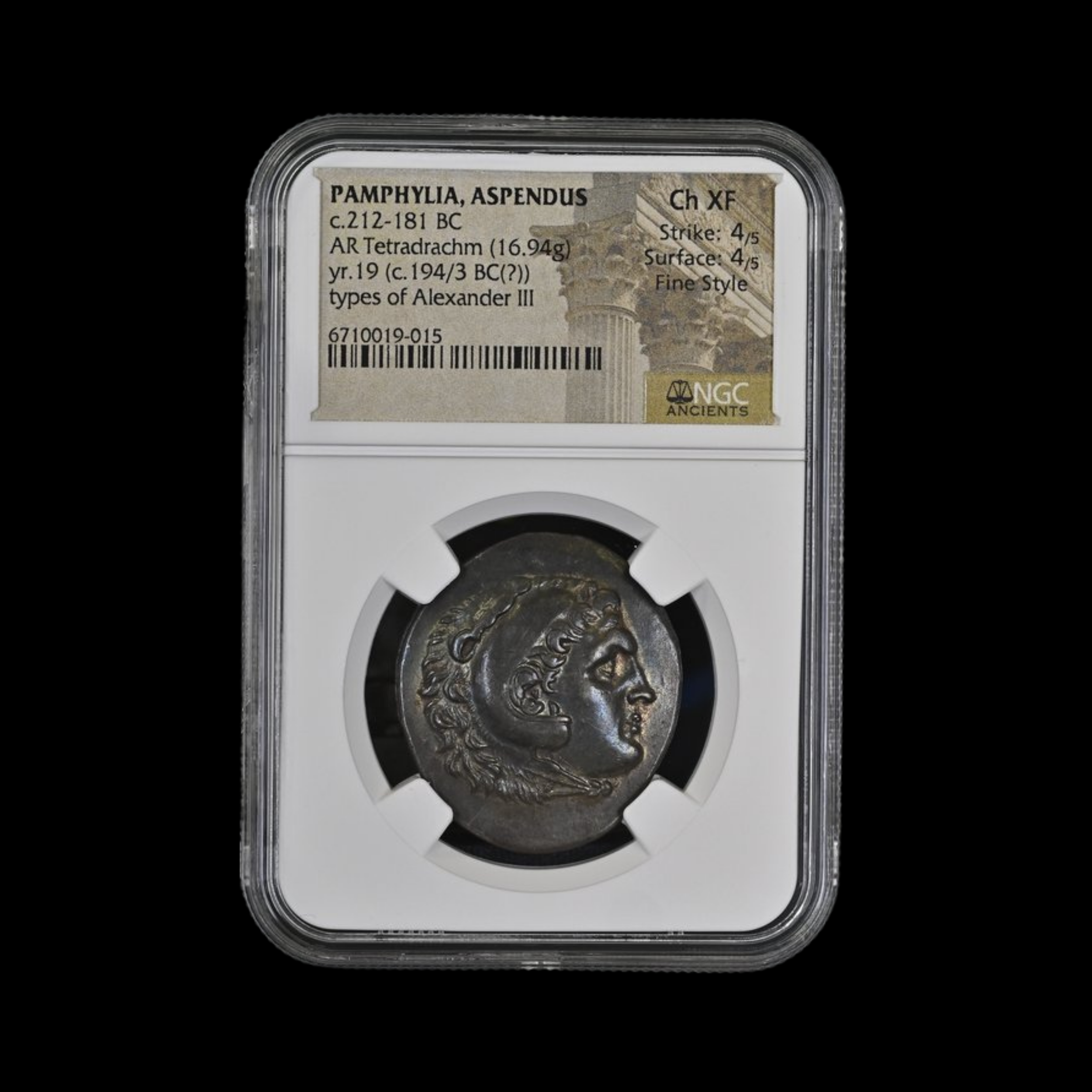 Image 1 of 2
Image 1 of 2

 Image 2 of 2
Image 2 of 2



Silver Tetradrachm of King Azes (about 2,080 years ago)
This coin is a silver tetradrachm from the Indo-Scythian Kingdom under King Azes I or II, minted after approximately 58 BCE. The Indo-Scythians were nomadic warriors of Central Asian origin who established kingdoms in what is now Pakistan, Afghanistan, and northwestern India. This large silver coin represents the fascinating blend of Greek, Persian, and Indian cultural elements that characterized this frontier civilization.
Coin Description:
Front side: The obverse typically shows King Azes on horseback, holding a spear or whip, with Greek-style inscriptions naming the king as "BASILEOS BASILEON MEGALOU AZOU" (Great King of Kings Azes).
Back side: The reverse likely depicts the Indian goddess Lakshmi or a Greek deity like Athena/Nike, often standing facing forward holding a wreath and palm branch. The reverse would include inscriptions in Kharoshthi script.
Technical Details:
Silver composition (AR)
Tetradrachm denomination (a large, high-value coin equal to four drachms)
Weight: Approximately 9-10 grams
Size: Approximately 25-30mm in diameter
NGC Grade: XF (Extremely Fine) - indicating excellent preservation with minor wear
Date of minting: After circa 58 BCE (late 1st century BCE to early 1st century CE)
Historical Significance: The Indo-Scythian kings Azes I and II ruled during a pivotal period when Central Asian nomadic peoples were establishing kingdoms across the former territories of the Indo-Greek kingdoms. Scholars debate the distinction between Azes I and II, which explains the ambiguous attribution of this coin. These rulers maintained Greek artistic and monetary traditions introduced by Alexander the Great's successors while incorporating Indian religious elements. This cultural fusion is evident in their bilingual coinage using both Greek and Kharoshthi scripts—a tangible symbol of East-West cultural exchange along the ancient Silk Road trading networks.
This coin is a silver tetradrachm from the Indo-Scythian Kingdom under King Azes I or II, minted after approximately 58 BCE. The Indo-Scythians were nomadic warriors of Central Asian origin who established kingdoms in what is now Pakistan, Afghanistan, and northwestern India. This large silver coin represents the fascinating blend of Greek, Persian, and Indian cultural elements that characterized this frontier civilization.
Coin Description:
Front side: The obverse typically shows King Azes on horseback, holding a spear or whip, with Greek-style inscriptions naming the king as "BASILEOS BASILEON MEGALOU AZOU" (Great King of Kings Azes).
Back side: The reverse likely depicts the Indian goddess Lakshmi or a Greek deity like Athena/Nike, often standing facing forward holding a wreath and palm branch. The reverse would include inscriptions in Kharoshthi script.
Technical Details:
Silver composition (AR)
Tetradrachm denomination (a large, high-value coin equal to four drachms)
Weight: Approximately 9-10 grams
Size: Approximately 25-30mm in diameter
NGC Grade: XF (Extremely Fine) - indicating excellent preservation with minor wear
Date of minting: After circa 58 BCE (late 1st century BCE to early 1st century CE)
Historical Significance: The Indo-Scythian kings Azes I and II ruled during a pivotal period when Central Asian nomadic peoples were establishing kingdoms across the former territories of the Indo-Greek kingdoms. Scholars debate the distinction between Azes I and II, which explains the ambiguous attribution of this coin. These rulers maintained Greek artistic and monetary traditions introduced by Alexander the Great's successors while incorporating Indian religious elements. This cultural fusion is evident in their bilingual coinage using both Greek and Kharoshthi scripts—a tangible symbol of East-West cultural exchange along the ancient Silk Road trading networks.
This coin is a silver tetradrachm from the Indo-Scythian Kingdom under King Azes I or II, minted after approximately 58 BCE. The Indo-Scythians were nomadic warriors of Central Asian origin who established kingdoms in what is now Pakistan, Afghanistan, and northwestern India. This large silver coin represents the fascinating blend of Greek, Persian, and Indian cultural elements that characterized this frontier civilization.
Coin Description:
Front side: The obverse typically shows King Azes on horseback, holding a spear or whip, with Greek-style inscriptions naming the king as "BASILEOS BASILEON MEGALOU AZOU" (Great King of Kings Azes).
Back side: The reverse likely depicts the Indian goddess Lakshmi or a Greek deity like Athena/Nike, often standing facing forward holding a wreath and palm branch. The reverse would include inscriptions in Kharoshthi script.
Technical Details:
Silver composition (AR)
Tetradrachm denomination (a large, high-value coin equal to four drachms)
Weight: Approximately 9-10 grams
Size: Approximately 25-30mm in diameter
NGC Grade: XF (Extremely Fine) - indicating excellent preservation with minor wear
Date of minting: After circa 58 BCE (late 1st century BCE to early 1st century CE)
Historical Significance: The Indo-Scythian kings Azes I and II ruled during a pivotal period when Central Asian nomadic peoples were establishing kingdoms across the former territories of the Indo-Greek kingdoms. Scholars debate the distinction between Azes I and II, which explains the ambiguous attribution of this coin. These rulers maintained Greek artistic and monetary traditions introduced by Alexander the Great's successors while incorporating Indian religious elements. This cultural fusion is evident in their bilingual coinage using both Greek and Kharoshthi scripts—a tangible symbol of East-West cultural exchange along the ancient Silk Road trading networks.
Azes II (Greek: Ἄζης ‹See RfD› Azēs, epigraphically ΑΖΟΥ ‹See RfD› Azou; Kharosthi: 𐨀𐨩 ‹See RfD› A-ya, ‹See RfD› Aya[1]), may have been the last Indo-Scythian king, speculated to have reigned circa 35–12 BCE, in what is Pakistan today. His existence has been questioned; if he did not exist, artefacts attributed to his reign, such as coins, are likely to be those of Azes I.[2]
After the death of Azes II, the rule of the Indo-Scythians in northwestern India and Pakistan finally crumbled with the conquest of the Kushans, one of the five tribes of the Yuezhi who had lived in Bactria for more than a century, and who were then expanding into India to create a Kushan Empire. Soon after, the Parthians invaded from the west. Their leader Gondophares temporarily displaced the Kushans and founded the Indo-Parthian Kingdom that was to last until the middle of the 1st century CE. The Kushans ultimately regained northwestern India circa 75 CE, where they were to prosper for several centuries.
Azes's name is attested on his coins in the Greek form ‹See RfD› Azēs (Ἄζης) and the Kharosthi form ‹See RfD› Aya (𐨀𐨩),[1] which are both derived from the Saka name *Aza, meaning "leader".[3]
















